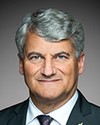It's wonderful to be here. For me, it's a trip back to Yellowknife. I've been fortunate, over my life, to spend time here, in Hay River, in Inuvik, and throughout much of the territories.
People in Whitehorse, Yukon, told us that whatever we do, don't lump them together. Their northern and cultural identities are all different, territory to territory.
I will address most of my questions to you, Dennis, because we MPs have been on a crash course, starting with what I'd call summer school. We spent all summer in hearings listening to a lot of experts. Then we hit the road, and this is our 10th day on the road to hear from Canadians from all over. We're hearing from people who have designed their own systems, some with a lot of experience from other countries and others not.
I'll pick up on one thing that may be an assumption, Dennis, around your comment that if we go to proportionality, we're going to have lists. There are a couple of proposals before us that don't involve lists at all. There's one proposal in front of us that actually involves increasing representation for the three northern territories. I want to put them to you.
We've had a lot of proposals from people who said to look at the New Zealand experience. It's been over 40 years; I'm forgetting the exact date. I'm sure that Scott will remember how many years it has been that the Maori population has had four specific seats just for Maori representation in their Parliament. Now it's seven specific seats, but on top of that, with proportionality, there are additional Maori MPs elected.
We heard from a young man in Edmonton named Sean Graham, who developed a system called dual member proportional. His system got the attention of the Government of Prince Edward Island, and they've put it as one of the choices on their plebiscite. The essence of dual member proportional is that we would couple the ridings, and each joint riding would have two representatives. You would never have to increase the number of MPs. The first representative is elected the normal way; the second is elected proportionally. The only problem he looked at across the country was what to do with Yukon, Nunavut, and the Northwest Territories? The solution is to add another seat there so they're not deprived of the opportunity for proportionality. That second seat would be based on how their party had done, and not just on how the person on the ballot had done.
I'm probably not explaining this adequately, but it does occur to me that we could defend a second seat for a very small population base if it were in the interest of ensuring better representation of indigenous people in Parliament. I'm thinking out loud, which is a dangerous thing to do on the record in a committee. If there were two seats each for Nunavut, the Northwest Territories, and Yukon, and if the second seat was both proportional and reserved for indigenous representation, I think that might be worth thinking about.
There's also a single transferable vote suggestion from Jean-Pierre Kingsley, where we would cluster all the ridings capable of being clustered. This generally means that rural and remote areas would keep first past the post voting, and proportionality would only be granted to those who live in ridings that can be clustered. You certainly suggested in your remarks, Dennis, that this would not be satisfactory to you, and that the benefits of proportionality should be extended to all.
Having given you a somewhat incoherent picture of a number of our options, I'd like to hear your thoughts on these ideas.




